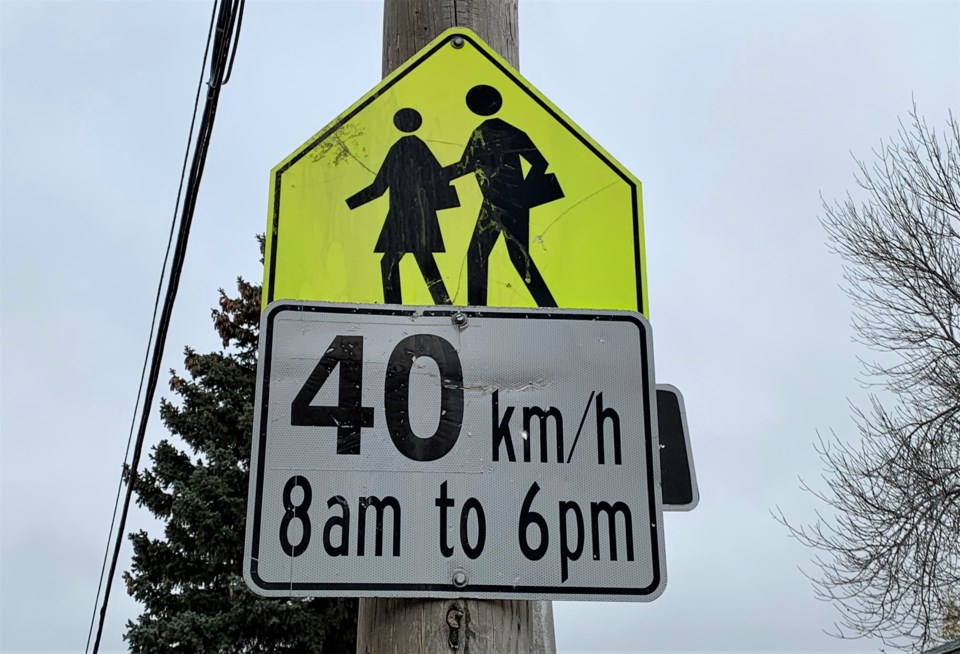MOOSE JAW — It will likely take time for residents to adapt to new school zone speeds once that change happens, which means police will use education to inform motorists instead of automatically distributing tickets.
City administration presented a comprehensive traffic bylaw amendment during city council’s May 27 executive committee meeting, with council unanimously approving a recommendation to consider it for three readings at the June 10 regular meeting.
If three unanimous readings occur, the bylaw will be effective immediately, enabling city crews to begin replacing almost 600 signs this summer through the Safe Routes to School Project, including 120 signs in school zones.
Those new signs will promote speeds of 30 km/h from 7 a.m. to 7 p.m. seven days a week.
Meanwhile, city hall will review playground signs this fall and refresh and upgrade signs and pedestrian crossings there in 2025.
Crews should finish installing the new signs before September — which is when enforcement will begin.
The bylaw also proposes 17 other changes, such as allowing city administration to move vehicles so construction can occur, strengthening language with general permit requirements and enforcement, providing clarity on U-turns and no-stopping areas, giving the city manager more authority to make decisions and adding fines.
The entire project should cost $500,000, including $300,000 for sidewalk rehabilitation and pedestrian ramp repairs in school zones and playgrounds, and $200,000 for traffic control, including replacing the 600 signs, completing the transportation master plan (TMP), replacing aging underground conduits and designing a signalized intersection for 2025.
A grace period
The TMP and consultant KGS Group helped city administration realize that Moose Jaw was “behind the times” with its school zone speeds, so both parties worked to develop an updated traffic bylaw that included reduced speeds, Bevan Harlton, director of operations, told council.
“From talks with the Moose Jaw Police Service, it said there would be a grace period where it would give warnings and instructions about school zone infractions, but at their discretion,” he continued.
To communicate these changes, city hall and the police will issue public service announcements to ensure residents know about the installation and commissioning of new signs, the fact the new speeds are active and that the police will provide a grace period before officially enforcing the new speeds.
Addressing safety concerns
Police Chief Rick Bourassa has confirmed there will be a “grace period” when the new signs go into effect, Coun. Doug Blanc said. However, the councillor wondered about the SGI-operated automated speed enforcement camera near William Grayson School and whether there would be forgiveness there, too.
Continuing, Blanc said he was eager for the speed-zone change because he’d driven past that school twice recently and noticed vehicles parked too close to the crosswalk, preventing other motorists from seeing children attempting to cross.
“If kids step out, you don’t have time,” he added.
Staff Sgt. Cam Lewis confirmed that the police service will have that camera updated and start enforcing the new limit and issuing tickets on Sept. 1 or the first day of school.
Loading vs. parking
Coun. Jamey Logan said the city will change some signs in school zones to no-stopping from no-parking ones, making him wonder whether there would still be loading zones and whether kids would have to “duck and roll” out car doors when arriving.
There will still be loading zones adjacent to school buildings and continual parking and traffic control measures around the properties, Harlton confirmed.
Painting crosswalks
Meanwhile, painting crosswalks will not be included as a project expense, as the city’s everyday operational budget will handle those costs, he continued. Instead, crosswalk painting will occur as part of city hall’s general efforts to align with national standards.
Harlton added that city hall would work with schools on this project and attempt to address their traffic and safety needs.
Blanc asked whether crews would repaint crosswalks regularly since city hall usually paints lines and then leaves them until they fade. Furthermore, he wondered if the city would add more physical crosswalks in school zones since many principals have told him they lack those access points.
“Crosswalks are some of the first line-painting that we do get done in public works. Operationally, this project wouldn’t seek to change the timeline of that work … ,” said Harlton. “However, we haven’t discussed improving our line painting scheme and what that may cost at this time.”
Also, the city will add 39 pedestrian ramp cutouts in school zones, focus on reducing speeds in those areas, ensure consistency with signs and maintain the number of student-crossing corridors, he added.
Coun. Heather Eby looked forward to the installation of new signs since they would look better and be more consistent and standardized, unlike how they are now, with one school zone having 12 no U-turn signs. She also thought it was important to reduce the speeds now instead of waiting for a collision to occur and then rushing to change everything afterward.
“I’m comfortable now with reducing speeds … (and) I’m really looking forward to cleaning up these ridiculous signs we have,” Eby added.
The next executive committee meeting is Monday, June 10.



